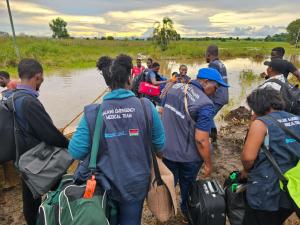Emergency Medical Team rescues Nkhotakota
It was a regular day in Mwansambo Village, Dwangwa Nkhotakota. Che Wisiki walked in the rain drizzles with his wife Patuma to their home, satisfied they had done enough to guarantee higher yields in the cropping season. Little did they know that these rain drizzles heralding hope would turn into a disaster.
In the wake of the following morning, Nkhotakota district had received heavy and persistent rains of approximately 215.2mm which went on from 28th February to 1st March 2. Resulting in the flooding of Dwangwa, Bua, Kaombe, and Kasitu rivers. The floods claimed over 8 lives, severely injured 9 people, displaced over 10,529 people, and affecting over 92,000 people who needed critical assistance.
“It was around 10 pm at night when we noticed water rising in our house. Patuma and the children took basins trying to cup out the water as I moved items around the house. We then heard a loud thump on the roof. Tree branches had dropped onto us, leaving that part of the house demolished. In that same moment, we heard a loud cry, we then remembered our youngest child had been sleeping. We found her in a pool of blood. In the steep darkness and heavy rains, with my entire family, we rushed to Katimbira Health Center. What we found there was a nightmare. The hospital was filled with water, partly demolished, and washing away. The storm was not calming down. Patients were being carried out of the hospital. Health workers and villagers looking at each other in awe of what to do,” narrates Che Wisiki.
From the Nkhotakota District Hospital analysis, six health facilities were affected in terms of capacity and medical supplies.
“Twelve camps were established in the Traditional Authorities of Mphonde and Kanyenda. Some health posts were also cut off under Katimbira, Kauli, Senjere, and Khonde. Furthermore, patients could not be referred to the District Hospital from the affected areas due to multiple road cut-offs. It was a sad situation. Critical patients, pregnant women who were already in the health centers in addition to those that had been injured from the flooding. In some cases, there was completely nothing to be done. People could not cross to the other side due to the angry waters,” said Dr. Jacob Kafulafula, Director of Health Services for Nkhotakota District.
With support from WHO Malawi and funding from the Foreign Commonwealth and Development Office FCDO, the Ministry of Health deployed a 12-member Type 1 National Emergency Medical Team (EMT) on March 4th, 2024, to support the district for a period of three weeks. They had to cross by boat with help from the Malawi Defense Force. Due to referral challenges, the EMT handled both EMT Type 1 and Type 2 services operating from Matiki, Khunga, and Ngala Health Centers, with visits to neighboring camps.
Dr. Limbani Mapata, the Team Leader of the Emergency Medical Team, narrates the EMT’s experience in Nkhotakota.
“We assisted with complicated cases including oligohydramnios, obstructed labor, uterine ruptures, infant respiratory distress syndrome, rib fractures, Galeazzi fracture, and compression of L2 vertebrae. We also provided mentorship on critical care to clinical teams in these health facilities. Due to extensive road damage, the team organized a relay referral system for cases needing secondary and tertiary care.
At the peak, the team could reach up to 400 consultations per day on a 24-hour rotation system. Cumulatively, the EMT had 8,093 consultations from the three health facilities and managed to refer 34 patients with different health conditions to the district hospital for further management. Malaria and Upper Respiratory Tract Infections (URTIs) cases were high. Schistosomiasis was prominent and linked to the presence of swampy areas in the communities. Viral Conjunctivitis was also prominent, especially in the camps. We can only be grateful to WHO. They provided the medical supplies and were ever present in the affected areas together with the surge team.”
Che Wisiki remains grateful to the EMT. He says without this team, his daughter would not have made it out alive.
“We had lost all hope. We had managed to slow the bleeding, but she was still bleeding. The health workers on the ground had done their best, but there were no resources. Their fear was an infection. The presence of these people brought us hope in a very hopeless situation,” laments Wisiki.




